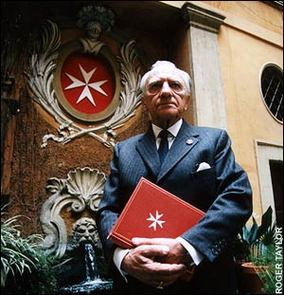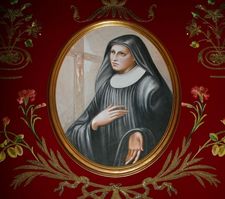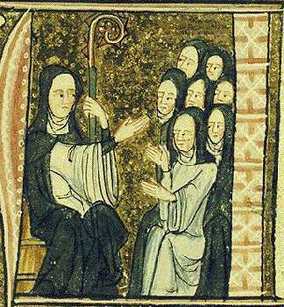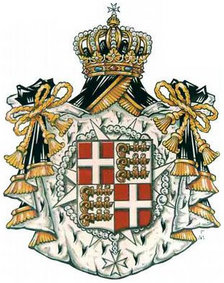 Dorothy Day is not a pawn in political camps. She is the darling of a political camp for either the seculars or the ecclesials. To apply political monikers of liberal and conservative, left or right is grossly inaccurate and a rather reductionistic manner to understand a person and her vocation, the vocation defined by love and happiness. True to an authentic follower of Christ, Dorothy Day’s vocation was to be a saint, that is singularly focussed on her Lord and Savior; her vocation was to adore and follow Jesus Christ. Day’s vocation was not to feed the the poor and argue for a change in governmental policy. As a friend said, Day’s life is too easily “framed in political terms by people who anachronistically use words like ‘liberal’ and ‘conservative’ to describe a life that was never about that fight.” Additionally, I fully agree with Martha Hennessy, 57, the granddaughter of Day who said she was uncomfortable about her grandmother’s abortion. Let’s pay attention to Martha Hennessy, “I wish we would focus on the birth of her child more than on her abortion because that’s what really played a role in her conversion.” Indeed. This is the pro-life position of the Church.
Dorothy Day is not a pawn in political camps. She is the darling of a political camp for either the seculars or the ecclesials. To apply political monikers of liberal and conservative, left or right is grossly inaccurate and a rather reductionistic manner to understand a person and her vocation, the vocation defined by love and happiness. True to an authentic follower of Christ, Dorothy Day’s vocation was to be a saint, that is singularly focussed on her Lord and Savior; her vocation was to adore and follow Jesus Christ. Day’s vocation was not to feed the the poor and argue for a change in governmental policy. As a friend said, Day’s life is too easily “framed in political terms by people who anachronistically use words like ‘liberal’ and ‘conservative’ to describe a life that was never about that fight.” Additionally, I fully agree with Martha Hennessy, 57, the granddaughter of Day who said she was uncomfortable about her grandmother’s abortion. Let’s pay attention to Martha Hennessy, “I wish we would focus on the birth of her child more than on her abortion because that’s what really played a role in her conversion.” Indeed. This is the pro-life position of the Church.
Tag: canonization
Dorothy Day’s vision of being a saint
 There are some among the Christian faithful who would prefer not to spend resources, personal and financial, on the sainthood investigation of the Servant of God Dorothy Day. As we know the US bishops have recently given their approval for the process to move forward. The for Day’s cause for canonization is being promoted by the Archdiocese of New York; Cardinal Timothy Dolan is a very strong supporter, as is Cardinal Francis George among others.
There are some among the Christian faithful who would prefer not to spend resources, personal and financial, on the sainthood investigation of the Servant of God Dorothy Day. As we know the US bishops have recently given their approval for the process to move forward. The for Day’s cause for canonization is being promoted by the Archdiocese of New York; Cardinal Timothy Dolan is a very strong supporter, as is Cardinal Francis George among others.I bear a burden of responsibility for publicizing that line, which I quoted in the introduction to an anthology of her writings almost thirty years ago. Where did it come from? I can’t honestly say. I do remember one time sitting at the kitchen table with her at St. Joseph’s house, looking at an issue of Time magazine in which she was included in a list of “living saints.” “When they call you a saint,” she said, “it means basically that you are not to be taken seriously.”
Whatever the provenance of her famous “quote”–the important question is: What did she mean?
Dorothy’s own relationship with saints was anything but cynical. Both her daily speech and her writings were filled with references to St. Paul, St. Augustine, St. Francis of Assisi, and St. Teresa of Avila. She treasured their stories. For Dorothy these were not idealized super-humans, but her constant companions and daily guides in the imitation of Christ. She relished the human details of their struggles to be faithful, realizing full well that in their own time they were often regarded as eccentrics or dangerous troublemakers.
But she didn’t just study their life and writings. She also firmly believed in their role as heavenly patrons. Whenever funds or provisions ran low she would “petition” St. Joseph. She would pray to St. Therese for patience and understanding. She would pray to St. Francis to increase her spirit of poverty. For many years, the Catholic Worker was largely illustrated by woodcuts by Ade Bethune depicting the saints in everyday dress, performing the works of mercy. She devoted many years of her life writing a life of St. Therese of Lisieux. I have no doubt she would have delighted in the news that St. Therese was named a Doctor of the Church. It is unthinkable that she would have responded by saying, “That means basically that Therese is not to be taken seriously!”
Furthermore, long before Vatican II took up the theme of the universal call to holiness, Dorothy Day taught that “we are all called to be saints.” As she noted, “We might as well get over our bourgeois fear of the name. We might also get used to recognizing the fact that there is some of the saint in all of us. Inasmuch as we are growing, putting off the old man and putting on Christ, there is some of the saint, the holy, the divine right there.” In other words, Dorothy Day regarded sanctity as the ordinary vocation of every Christian–not just the goal of a chosen few.
What Dorothy certainly opposed–and what saint wouldn’t?–was being put on a pedestal, fitted to some pre-fab conception of holiness that would strip her of her humanity and, at the same time, dismiss the radical challenge of the gospel. “Dorothy Day could do such things (live in poverty, feed the hungry, go to jail for the cause of peace). She’s a saint.” For those who said this sort of thing, the implication was that such actions–which would be out of reach for ordinary folk–must have come easily for her. She had no patience for that kind of cop-out.
Dorothy Day’s cause for canonization gets US bishops approval
 The canonization process of the Servant of God Dorothy Day (1897-1980) the US Conference of Catholic Bishops (USCCB) by an unanimous voice vote on November 13, 2012 at the annual meeting of the bishops.
The canonization process of the Servant of God Dorothy Day (1897-1980) the US Conference of Catholic Bishops (USCCB) by an unanimous voice vote on November 13, 2012 at the annual meeting of the bishops.
Sanctorum Mater (2007), requires of the diocesan bishop promoting a sainthood cause to consult at least with the regional bishops’ conference on the work of the cause.
Regarding Dorothy Day, she is a very well-known figure who is often connected with her stances on the economics and politics; the Catholic Worker movement that she co-founded is seen as a socialist and not too Catholic today. Day was based in New York City and her cause of canonization is being promoted by Timothy Cardinal Dolan, archbishop of New York and current president of the USCCB.
We know that in 1933 Dorothy Day co-founded the Catholic Worker movement with Peter Maurin, as a Catholic, personal response to those who lived on the margins. Sadly, Day is most remembered for the incidental things of work with the poor and a direct critique of the systems that kept them poor and peace. But do we know and appreciate, even follow Day as a 1927 convert to Jesus Christ and her intense love for the Church? As the late Father Richard John Neuhaus once said Day was “deeply grounded in fidelity to Catholic faith.”
Of the places Dorothy Day prayed, Saint Michael’s Russian Catholic Center was one of them. She apparently loved to pray the Divine Liturgy.
Yesterday Cardinal Dolan called Day “Augustinian,” in that “that “she was the first to admit it: sexual immorality, there was a religious search, there was a pregnancy out of wedlock, and an abortion. Like Saul on the way to Damascus, she was radically changed” and has become “a saint for our time.” In fact, Dorothy Day was a Benedictine for these same reasons. Not that being an Augustinian is a bad thing, but her heart was rooted in the charism of Saint Benedict even before her 1955 Oblation as a lay Benedictine.
History tells us that “Dorothy Day met [Saint Procopius] monks at parish in NYC in the fifties. She became an oblate in 1955 primarily due to Father Rembert Sorg’s writings on the theology of manual labor. Father Brendan McGrath, scripture scholar of the community, received her oblation. She befriended Benedictine Father Chrysostom Tarasevich whom she met at the NYC Byzantine Catholic Russian Center.
Fulton J. Sheen, Mother Angeline Teresa advances another step toward sainthood
Two “New Yorkers” advance in the study of their sanctity: Fulton J. Sheen and Mother Angelina Teresa.
Today, Pope Benedict XVI gave his permission for the promulgation of the decree concerning the “heroic virtues” of now Venerable Servant of God Fulton J. Sheen (1895-1979). Sheen was a great communicator of the faith in the 20th century. His winning personality and sincerity drew people to Christ.
A wonderful development is the recognition that Brigida Teresa McCrory (1893-1984) known as Mother Angelina Teresa, foundress of the Carmelite Sisters of the Aged and Infirmed, lived a life of heroic virtue. This is good news because it highlights the good work these Carmelite sisters continue to do, notably around the corner from St Catherine of Siena Church (NYC).
Moreover, he did the same for the former Prelate of Opus Dei, the Servant of God Alvaro del Portillo y Diez de Sollano, Spanish prelate of the Personal Prelature of the Holy Cross and Opus Dei (1914-1994). He was the immediate successor to Saint Josemaria.
Angelo Cardinal Amato SDB, prefect of the Congregation for the Causes of Saints, presented these and other causes for sainthood.
UPDATE: Cardinal Dolan writes about the 2 New Yorkers…
Pope recognizes Benedictine nun as a saint, others of the USA as having heroic virtue
This morning the Holy Father had received in a private audience Angelo Cardinal Amato, SDB, Prefect of the Congregation of the Causes of Saints, who presented the cases for sainthood that his office has been working on.
Among the many important things decided, the Pope has given us the liturgical memorial of and inscribed in the catalog of Saints of the Universal Church, the model of holiness in the person of Saint Hildegard of Bingen, a German Benedictine nun born in Bermershein in 1089 and who died in Rupertsberg on 17 Septemeber 1179.
What is interesting here is that Hildegard never really went through the same process of canonization that’s done nowadays so you can say the Church is recognizing her sanctity and place with God without the rigorous investigation that is being done for the Venerable Servant of God Michael J. McGivney. In part, this is because through the centuries the Church has changed several times, the process by which it is judged a person is a blessed or saint. Previously, people used the title “saint” with Hildegard as “popular theology and cult of the saints.”
So, with this ecclesial recognition Saint Hildegard of Bingen may be honored officially as a saint of the Church. She may be considered the Church’s newest Benedictine saint.
Fra’ Andrew Bertie’s study in the cause for beatification opened
 The Grand Magistry of the Order of Malta has informed its members that the process to study toward the beatification of the former Grand Master and Prince, Fra’ Andrew Willoughby Ninian Bertie.
The Grand Magistry of the Order of Malta has informed its members that the process to study toward the beatification of the former Grand Master and Prince, Fra’ Andrew Willoughby Ninian Bertie.
motto of the order is Tuitio Fidei et Obsequium Pauperum, “Defense of the Faith and Service of the Poor.”
having about 13, 000 Knights and Dames, 80,000 volunteers (15,000 trained as doctors and nurses), and a presence in 200 hospitals. The Order has an official presence in 120 countries. I am sure the data could be updated.
Walter Ciszek’s advances incrementally to sainthood
 Moving around the circles of the Catholic press is the noteworthy acceptance as valid of the cause of beatification and canonization of Father Walter J. Ciszek, SJ, (1904-84) by the Holy See’s Congregation for the Causes of Saints.
Moving around the circles of the Catholic press is the noteworthy acceptance as valid of the cause of beatification and canonization of Father Walter J. Ciszek, SJ, (1904-84) by the Holy See’s Congregation for the Causes of Saints.
Continue reading Walter Ciszek’s advances incrementally to sainthood
Communion and Liberation opens cause for beatification and canonization for Luigi Giussani today
 Father Julián Carrón, the President of the Fraternity of Communion and Liberation, the ecclesial movement founded Father Luigi Giussani (who died 7 years ago today) and which was approved by the Church 30 years this past February 11, gave the preliminary research to Angelo Cardinal Scola, Archbishop of Milan, to open the diocesan phase of investigating the eventual beatification and canonization of Father Luigi Giussani.
Father Julián Carrón, the President of the Fraternity of Communion and Liberation, the ecclesial movement founded Father Luigi Giussani (who died 7 years ago today) and which was approved by the Church 30 years this past February 11, gave the preliminary research to Angelo Cardinal Scola, Archbishop of Milan, to open the diocesan phase of investigating the eventual beatification and canonization of Father Luigi Giussani.
Miracles, heroic virtue, new blesseds, new saints, 2 Americans
Sixty-seven people who are being proposed for sainthood had their causes advanced today when Angelo Cardinal Amato, SDB, Prefect of the Congregation for the Causes of Saints presented the respective cases to His Holiness, Pope Benedict XVI.
Several were recognized as martyrs for the Faith; their witness to Christ resulted in their being killed in hatred of the faith (odium fidei). 7 who were identified as living a life of heroic virtue were women who founded religious congregations of sisters.
Others were diocesan and religious priests, nuns, sisters and lay people. The martyrs came from Spain having died in the mid-1930s. Of note to me was…
 ~the recognition of the miracle attributed to the intercession of the Servant of God Maria Luisa (nee Gertrude Prosperi; 1799-1847; image) an Abbess of the Benedictine Abbey in Trevi;
~the recognition of the miracle attributed to the intercession of the Servant of God Maria Luisa (nee Gertrude Prosperi; 1799-1847; image) an Abbess of the Benedictine Abbey in Trevi;
~the recognition of the miracle attributed to the intercession of the Blessed Kateri Tekakwitha (1654-1672), an American lay woman and first Native American;
~the recognition of the miracle attributed to the intercession of the Blessed Marianne Cope (nee Barbara; 1838-1918), a Franciscan sister who worked with Saint Damian of Molokai.
The Filipino community gets its second saint with the acceptance of the miracle attributed to Blessed Pedro Calungsod (1654-1672), a lay catechist.
Clelia Merloni’s canonization cause advances, miracle investigated
Continue reading Clelia Merloni’s canonization cause advances, miracle investigated





